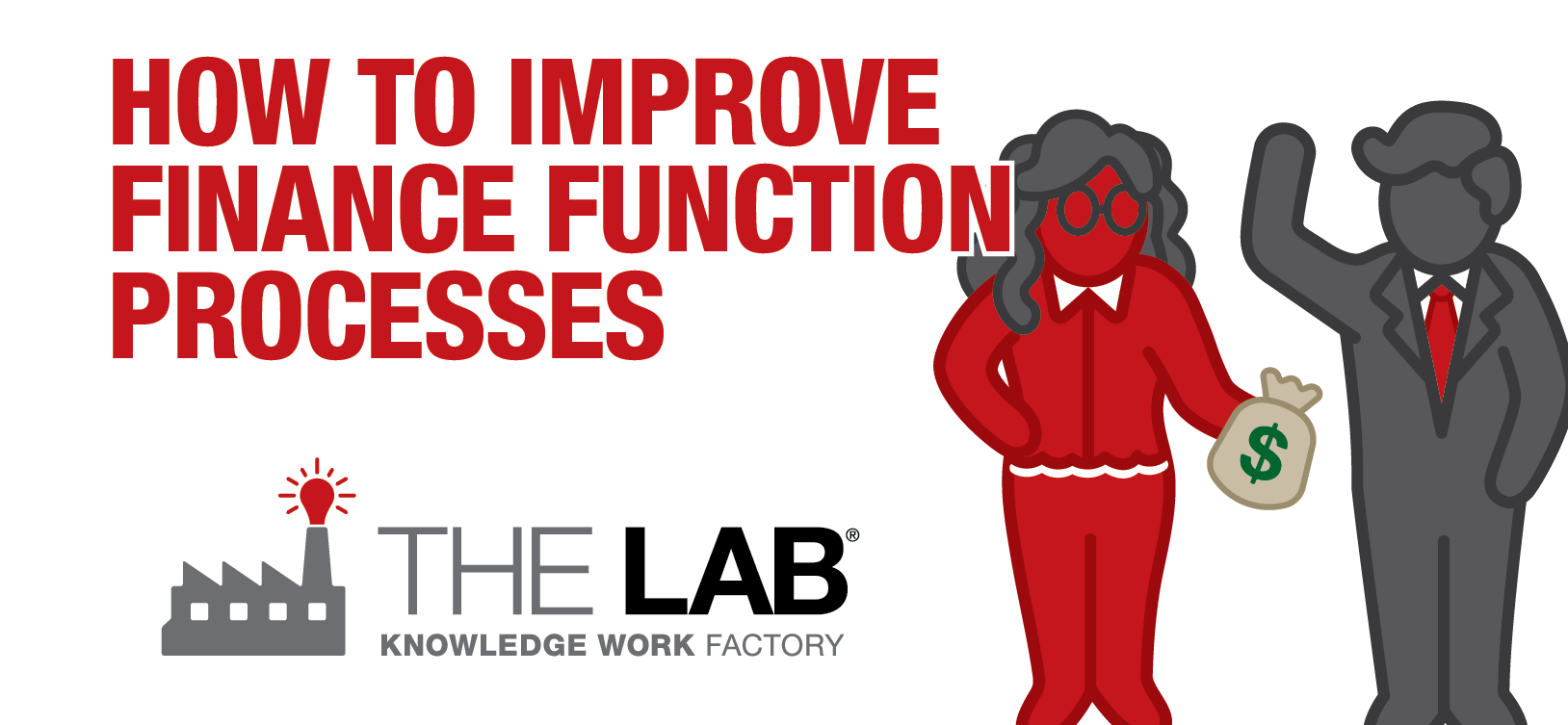This client initiative summary case study on lean finance process improvement and transformation concerns a Top 5 U.S. bank, a leader in residential mortgages and small-business lending.
They were under pressure to undertake a lean finance and accounting transformation. And they were facing continuing cost increases—higher than what management desired. Despite bank-wide growth, they needed to deliver the required reporting and improve operational efficiency without increasing operating costs.
Creating the lean finance function: Identifying process improvement opportunities
The Executive Vice President of this bank’s consumer lending group, along with the bank’s CFO, reached out to The Lab. They sought lean corporate finance team transformation. They also sought the application of lean principles to their individual business unit finance function teams.
The Lab set to work, bringing a lean approach to this bank. The scope of the finance transformation project was extensive. It spanned 2,000 finance-operations people across 13 locations, and included functions such as:
- Finance shared services.
- Finance operations.
- Controller function.
- Auto finance.
- Debit/credit card finance.
Over the course of just eight weeks, The Lab was able to identify more than 400 lean finance process improvements across both the shared services organizations’ and individual business-unit finance functions. And not one of these required new technology. Consider some of the lean finance transformations lessons:
Lean Finance Transformation Lesson 1: Lean finance process improvement implements “de-fragmented” work activities
Within the finance function, The Lab uncovered 750 discrete work activities, and 300 separate processes. This wasn’t lean finance; it was more like “bloated processes.” All of these activities made it difficult to apply lean finance principles, as it was hard to mange work routines, and even harder to control staff resources.
Specifically, The Lab revealed that 40 percent of finance work tasks were due to process rework. Why? There was a lack of standardized procedures for inbound finance and accounting data submission. The bank’s different business units simply “threw data over the wall”; as a result, Finance continually needed to reconcile and re-analyze it.
By implementing standard lean data-submission procedures and KPIs to measure adherence to processes for inbound data from the different business units, The Lab was able to slash this wasted effort by 70 percent. That’s lean finance in action.
Could your finance function benefit from lean process improvement implementation in its operations? How many fragmented work activities do you think are lurking within that function right now?
Lean Finance Transformation Lesson 2: A transformed organization measures its finance operations effectively and avoids bloated reporting
How can you apply a lean strategy to operations or process improvement if you lack essential operating metrics? At the time of The Lab’s intervention, this bank had few operating measures to monitor daily routines and control the workday. Thus they couldn’t tell which employees were producing reports using 20 percent—or 100 percent—of their time.
This huge disparity translated to excessive overhead costs. Low performers plodded along, bloating the payroll. Taking a lean approach, The Lab implemented productivity KPI tracking to drive down unproductive work time—and drive up finance function value.
Compounding this lack of insight was needless complexity. Finance operations was in the habit of creating more than 800 reports for line executives. You won’t be surprised to learn that many of these reports went un-reviewed and un-used. That’s the wrong way to approach finance function reporting. But you will never know it is there if you don’t look for it from an end-to-end perspective.
The Lab was able to combine or eliminate 40 percent of these reports. Finance function staff, in turn, were reallocated to focus on month-end close process improvement—and soon were able to reduce monthly close cycles from 18 days to just ten, with help from The Lab.
Lean Finance Transformation Lesson 3: Lean finance process improvement principles demand optimum capacity planning
Does your finance function have a lean transformation plan for allocating staff resources? This finance team, we discovered, had room to improve. Its mechanisms for planning staff resources, especially in its business unit finance function operations, were ad hoc and poorly administered. Every one of its 13 finance-function locations estimated their staffing requirements in a different way. Most locations just had as many employees as the budget would allow them—even if they weren’t needed to process the work!
What’s worse, managers set expectations based on sub-standard performance levels. This left leadership effectively blind to a lean approach to understanding—and modeling—true capacity.
The Lab stepped in and implemented lean finance function capacity planning measures across all locations. We standardized these into an executive dashboard which reduced operating costs by ten percent alone. This allowed management to staff against volumes of work instead of backing into a budget.
Lean Finance Transformation Lesson 4: Lean principles in finance translate to broad spans for management
Within both the shared services and business unit finance operations of this bank, the spans of management (that is, the number of subordinates working under any given supervisor) were quite narrow: Multiple locations had one manager for every three employees. In this regard, they lagged competitors by more than 40 percent.
This highlighted a significant opportunity for cost improvement, using lean finance principles. The Lab helped. We consolidated middle management staff to reduce excessive overhead cost at all 13 locations.
If you benchmarked your finance function’s management spans against industry leaders, how would they stack up? Can you claim to have a truly lean enterprise?
Lean shared services, lean business unit finance functions: The transformation results
The impact of addressing these areas of improvement in finance departments—and ensuing lean transformation—was undeniable:
- Management spans increased more than 15 percent.
- Headcount requirements dropped more than 25 percent.
- Operating cost plummeted more than 18 percent.
- Rationalized reporting dropped more than 35 percent.
Even more impressive, this transformation initiative yielded nearly $8 million in recurring annual savings. The finance group operations engagement with The Lab paid for itself in just four months; by Month 12, the investment in The Lab paid itself back seven times over.
Is your team truly lean in finance and accounting? If this lean finance function case study strikes a chord with you, then learn more about The Labs transformation services. We employ a unique self-funding engagement model and irresistible money-back guarantee.
Simply call (201) 526-1200 or email info@thelabconsulting.com for a quote to get started on a finance transformation project today.


















